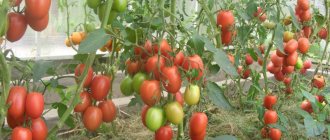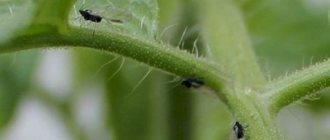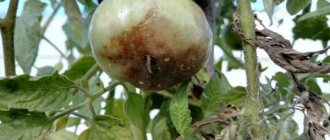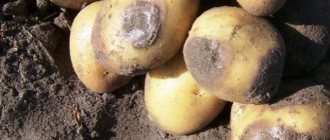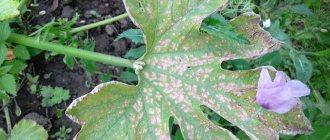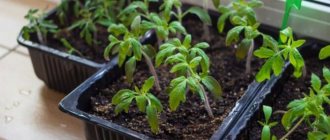Among the fungal infections that affect vegetable crops, late blight on potatoes, tomatoes, and other plants is considered the most insidious. Now we will talk about root vegetables. Over many years of experience in growing nutritious tubers, I have learned to cope with this scourge. Although it is not possible to completely eradicate the pathogen, prevention helps keep the disease in check. Under unfavorable conditions, the crop can be saved if treatment is started on time.
What is late blight, the reasons for its occurrence
In the English-speaking segment of the Internet, the disease is called “Late blight”. This is due to the fact that pathogens of potato late blight exhibit their highest activity in the second half of summer, during the warm period of fog and rain.
Phytophthora infestans is a complex spore-forming organism that is dangerous to plants. During the division of mother cells, it forms three types of spores: conidiospores, zoospores and oospores. Oospores, covered with a durable shell, live on the surface of the ground, potato bushes, root crops, and in vegetable stores.
Potato parts affected by late blight
When exposed to a warm, humid environment, oospores begin to divide, drawing strength from the fibers of the plants they parasitize. During division, they turn into conidia, which, when dry, are carried by the wind everywhere. Under favorable conditions, conidia begin to transform into motile zoospores.
Zoospores, within 2-3 hours of being in heat and moisture, are able to penetrate plant cells and begin to multiply and feed on the contents of the cells, creating an extensive mycelium. Plant cells die, necrotic areas form on leaves, stems, and potato tubers. The mycelium produces new conidia, which become sources of new infections.
For reference! Late blight affects almost any plant: grasses, shrubs, trees, causing their diseases, including wilting, drying out, and rot.
What does late blight look like on potatoes?
You can tell that a potato has become infected with late blight by the following characteristic signs:
- elongated, merging gray-brown spots cover the above-ground parts of the potato;
- inflorescences, peduncles, sepals turn black and dry out;
- at high air humidity, a white fluffy oily coating grows around the spots;
- Subcutaneous brownish-brown spots form on the tubers, they grow, the fruit softens, and gradually turns into a dark brown rotting pulp.
Important! The fluffy white coating on the leaves and stems is activated Phytophthora zoospores. They participate in further infection of the host plant, when dry, they are spread by the wind to other bushes, germinate on the leaves, and when they fall into rain streams they are washed into the soil.
Mycelium on potato leaves
Signs of the disease
At an early stage of potato infection, the fungus can be identified by brown or black translucent spots of unclear shape on the lower leaves of the bush.
Later, the color of the darkening becomes more saturated, the black areas increase in size, covering the entire leaves.
In damp weather, the affected tissues on the underside of the plates are surrounded by a light coating of a cobweb structure. Over time, symptoms appear on young leaves.
Usually the first signs of the disease are visible shortly before the buds open or at the beginning of flowering. Occasionally, spots appear on buds, flower calyxes and ovaries.
Black streaks and specks form on the stems and petioles, some of them turn into constriction rings, causing fractures.
The fungus leaves gray or light brown depressed areas on root vegetables.
The cut reveals rusty or brown wedge-shaped areas, sometimes reaching the middle of the tuber. The affected pulp does not soften, but becomes woody.
The course of the disease depends on the weather. During rainy periods, damaged leaves rot and die, giving off a strong musty smell.
If the weather is dry, the leaves curl, dry out and fall off.
Causes of late blight in potato beds
Sometimes gardeners do not notice the moment when potato tops are affected by late blight. After all, pathogens from root crops located underground penetrate the stems from the inside through plant cells.
In this case, necrosis spots form in the lower part of the stems, on the lower rows of leaves. And healthy potato tubers become infected during the harvesting period, upon contact with infected tops and soil surface. The pathogen penetrates root crops through the eyes and areas of the fruit where the skin is missing.
If a potato is infected with late blight, then its spores will remain in the soil in the places where the affected tubers grew. Pathogens will live there for several years and gradually accumulate in large quantities.
They and the remaining undug tubers will become sources of infection of new seed roots planted in future years. Therefore, the main requirement of the rules of agricultural technology for growing potatoes and other representatives of the nightshade family is compliance with the order of planting vegetable crops. Potatoes are not planted on the same piece of land more than 2 years in a row.
Note! Damage to potato tubers by late blight begins at temperatures from 20 to 24°C, and Phytophthora spores multiply when the soil is heated from 12 to 18°C.
The most favorable periods for mass infection of potato fields with late blight are the rainy summer months, when frequent precipitation gives way to fog and heavy dew in the mornings.
Scheme of infection of potato bushes with Phytophthora spores
Sexual cycle
Phytophthora can form germ cells on the mycelial processes. Upon fusion, the antheridia, elongated male cells, pour their contents into oogonia, spherical female cells. After this, the oogonia is covered with a thick membrane, forming an oospore.
Reproduction occurs inside plant tissue; the oospore remains undisturbed until it is completely decomposed. Once on the ground along with the tops, the spore penetrates the soil along with water.
Underground, it can retain the ability to germinate for up to 4 years in sandy soil or up to 3 years in loam. The oospore either sprouts into a tuber or forms a zoosporangium.
Chemical control agents
It is possible to cure potato plantings from late blight only if you carry out an annual deep digging of the soil in the potato beds. It is necessary to dig out from the ground not only the potatoes of this year's harvest, but also the mother tubers. During harvesting, be sure to remove and burn potato tops that have been affected by late blight. Healthy tops remains are disposed of.
You can treat the soil from residual foci of late blight using copper sulfate. This drug is also used to treat planting material.
How to treat potatoes with copper sulfate against late blight
The soil on which vegetables are grown should not accumulate copper ions, which are part of the drug called “Copper sulfate”. Therefore, treatment of potato beds with copper sulfate is carried out once every 5 years.
To prepare solutions containing copper, do not use metal utensils. To disinfect the soil, 16 g of CuSO4 (1 tbsp) is mixed with 10 liters of water. First, pour some warm water into a plastic bucket and dilute copper sulfate, then, stirring constantly, add the rest of the water.
Planting potatoes are treated with a combined composition. The mixture is prepared from 10 liters of water, 5 g of CuSO4, 1 g of potassium permanganate, 10 g of boric acid.
To prevent late blight, potato shoots that have reached a height of 20 cm are treated with a mixture of 2 g of copper sulfate and 10 liters of water. This will make it possible to postpone the period of activation of Phytophthora infestans to the hot period of summer. At high air temperatures, the physiological activity of zoospores stops.
Additional Information! Before you start treating the soil or plants with copper sulfate mixtures, the solution is filtered and then poured into a sprayer.
Copper sulfate for processing vegetable crops
Selection and processing of tubers before planting
Planting material should be carefully selected even at the time of harvesting potatoes, always in dry sunny weather, making sure that infected specimens are not accidentally lost among the seed potatoes.
Before storing the tubers, they are dried for 2-3 weeks in a dry, dark room with good ventilation, and then inspected again. If during this time tubers with signs of late blight are found in the planting material, they will need to be disposed of.
Only whole, undamaged tubers are placed for storage in a layer of no more than 1 m. Proper conditions are created for them in the storage - a temperature of about 2-3 ° C, humidity - 80-90%, darkness and good ventilation.
Potatoes stored all winter need to be re-inspected before planting. The set must have a healthy, undamaged appearance. If you have been growing this crop not so long ago, you can choose varieties that are resistant to late blight for planting. These are Vesna, Golubizna, Zarya, Lugovskoy, Nevsky, Nida, Red Scarlett, Reserve, Skoroplodny, Timo, Udacha and others.
Before planting the potato variety you like, be sure to check whether it is suitable for growing in your region.
When planting early varieties, choose tubers weighing at least 50 g.
Before planting, the tubers are treated with special drugs against diseases. To do this, you can use Maxim (40 ml per 1 liter of water), Maxim Dachnik (4 ml per 100 ml of water), Kagatnik (50-80 ml per 1 liter of water), Fitosporin-M and other biofungicides.
Folk remedies against late blight
The use of traditional methods of combating late blight is permissible if plants are just beginning to develop late blight. Overcoming a fungal infection is not easy. In order to save the harvest when Phytophthora infestans is activated, folk remedies are not used.
For preventive purposes, you can use repeated dusting of potato bushes and row spacing with wood ash. An infusion is made from the ash powder: 1 liter of ash is diluted in 2 liters of hot water. Leave for 72 hours, filter, spray the potato tops after emergence, during budding, after flowering. Potato tubers are soaked in the same solution before planting in holes.
Classification of antifungal drugs for the protection and treatment of potatoes
Antifungals act against pathogens in different ways. Fungicidal preparations, depending on the method of action on pathogens, are divided into several groups:
- Translaminar - cannot be distributed throughout the entire vascular system of plants; they penetrate plant tissues only to a small depth and kill pathogens located in this area. The drugs Fielder, Revus, and Retengo are produced with these characteristics.
- Contact - kill colonies of fungi located on the surface of plants, do not penetrate into plant cells.
- Systemic fungicides - spread along plant fibers both on the surface and inside the plants.
To protect potato crops, the industry produces mixed preparations consisting of fungicides of several modes of action: Oxychom, Pilon, Avixil, Arcerid, Acrobat, Ridomil Gold. All fungicides have a waiting period after application. This means that only after these periods have expired can vegetables be used for food.
Note! Vegetable crops treated with biological products based on living microorganisms cannot harm human health. These drugs include Fitosporin, Alirin, Gamair.
Prevention of late blight on potatoes
Preventive measures in the beds, where late blight was not rampant, but was still present, begin during harvesting. Before you start digging potatoes, a week before you start harvesting, cut off all the tops.
If late blight appears on potatoes, what to do with the tops? Considering the above, there is only one answer. All shoots are collected, taken away from the beds and burned. After harvesting the potatoes, all weeds and other plants growing next to the potato beds are also destroyed.
In addition, it is recommended to carefully inspect all the dug holes, rake the soil and collect the mother tubers, so that they can also be destroyed later.
Tillage after harvest
In order to prevent the activation of late blight, after harvesting potato beds where an outbreak of late blight has been recorded, the soil is treated with Fitosporin, a drug considered the most effective safe means of protecting vegetable crops from fungal infections.
Important! For 3 years, neither potatoes nor other nightshade crops are planted in this place.
Before planting in beds, root crops are treated with antifungal agents, such as Maxim, Prestige.
Late blight is a dangerous plant disease that can leave gardeners without a harvest of their favorite root crop. But it is possible and necessary to fight it. The choice of protective equipment allows you to do this without compromising human health.
Security measures
Carrying out chemical treatments requires strict adherence to safety rules:
- Perform the procedure in waterproof clothing, gloves, safety glasses, and a respirator.
- Do not eat, drink or smoke until work is completed.
- After the procedure, change clothes, wash your hands and face, equipment, and wash your clothes.
- Always follow the dosage of the product and the waiting period before harvesting, and do not exceed the permissible number of treatments.
- Do not mix medications.
- Pay attention to the instructions; many fungicides must be used immediately after preparation.
- Remaining solutions should not be poured near water sources; bury them on a hill outside the site.
- Drugs should be stored in places inaccessible to children and animals.
- Most products, even non-toxic to mammals and fish, pose a danger to insects.
- If there is an apiary near the site, bees should be limited during the period of spraying.
